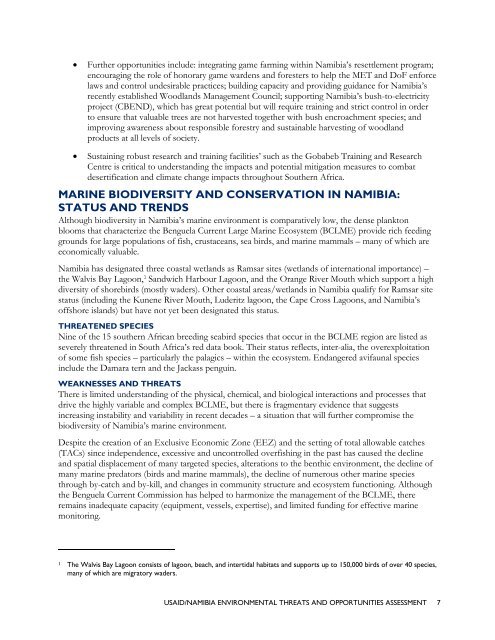usaid/nambia environmental threats and opportunities assessment
usaid/nambia environmental threats and opportunities assessment
usaid/nambia environmental threats and opportunities assessment
Create successful ePaper yourself
Turn your PDF publications into a flip-book with our unique Google optimized e-Paper software.
Further <strong>opportunities</strong> include: integrating game farming within Namibia’s resettlement program;<br />
encouraging the role of honorary game wardens <strong>and</strong> foresters to help the MET <strong>and</strong> DoF enforce<br />
laws <strong>and</strong> control undesirable practices; building capacity <strong>and</strong> providing guidance for Namibia’s<br />
recently established Woodl<strong>and</strong>s Management Council; supporting Namibia’s bush-to-electricity<br />
project (CBEND), which has great potential but will require training <strong>and</strong> strict control in order<br />
to ensure that valuable trees are not harvested together with bush encroachment species; <strong>and</strong><br />
improving awareness about responsible forestry <strong>and</strong> sustainable harvesting of woodl<strong>and</strong><br />
products at all levels of society.<br />
<br />
Sustaining robust research <strong>and</strong> training facilities’ such as the Gobabeb Training <strong>and</strong> Research<br />
Centre is critical to underst<strong>and</strong>ing the impacts <strong>and</strong> potential mitigation measures to combat<br />
desertification <strong>and</strong> climate change impacts throughout Southern Africa.<br />
MARINE BIODIVERSITY AND CONSERVATION IN NAMIBIA:<br />
STATUS AND TRENDS<br />
Although biodiversity in Namibia’s marine environment is comparatively low, the dense plankton<br />
blooms that characterize the Benguela Current Large Marine Ecosystem (BCLME) provide rich feeding<br />
grounds for large populations of fish, crustaceans, sea birds, <strong>and</strong> marine mammals – many of which are<br />
economically valuable.<br />
Namibia has designated three coastal wetl<strong>and</strong>s as Ramsar sites (wetl<strong>and</strong>s of international importance) –<br />
the Walvis Bay Lagoon, 1 S<strong>and</strong>wich Harbour Lagoon, <strong>and</strong> the Orange River Mouth which support a high<br />
diversity of shorebirds (mostly waders). Other coastal areas/wetl<strong>and</strong>s in Namibia qualify for Ramsar site<br />
status (including the Kunene River Mouth, Luderitz lagoon, the Cape Cross Lagoons, <strong>and</strong> Namibia’s<br />
offshore isl<strong>and</strong>s) but have not yet been designated this status.<br />
THREATENED SPECIES<br />
Nine of the 15 southern African breeding seabird species that occur in the BCLME region are listed as<br />
severely threatened in South Africa’s red data book. Their status reflects, inter-alia, the overexploitation<br />
of some fish species – particularly the palagics – within the ecosystem. Endangered avifaunal species<br />
include the Damara tern <strong>and</strong> the Jackass penguin.<br />
WEAKNESSES AND THREATS<br />
There is limited underst<strong>and</strong>ing of the physical, chemical, <strong>and</strong> biological interactions <strong>and</strong> processes that<br />
drive the highly variable <strong>and</strong> complex BCLME, but there is fragmentary evidence that suggests<br />
increasing instability <strong>and</strong> variability in recent decades – a situation that will further compromise the<br />
biodiversity of Namibia’s marine environment.<br />
Despite the creation of an Exclusive Economic Zone (EEZ) <strong>and</strong> the setting of total allowable catches<br />
(TACs) since independence, excessive <strong>and</strong> uncontrolled overfishing in the past has caused the decline<br />
<strong>and</strong> spatial displacement of many targeted species, alterations to the benthic environment, the decline of<br />
many marine predators (birds <strong>and</strong> marine mammals), the decline of numerous other marine species<br />
through by-catch <strong>and</strong> by-kill, <strong>and</strong> changes in community structure <strong>and</strong> ecosystem functioning. Although<br />
the Benguela Current Commission has helped to harmonize the management of the BCLME, there<br />
remains inadequate capacity (equipment, vessels, expertise), <strong>and</strong> limited funding for effective marine<br />
monitoring.<br />
1 The Walvis Bay Lagoon consists of lagoon, beach, <strong>and</strong> intertidal habitats <strong>and</strong> supports up to 150,000 birds of over 40 species,<br />
many of which are migratory waders.<br />
USAID/NAMIBIA ENVIRONMENTAL THREATS AND OPPORTUNITIES ASSESSMENT 7

















